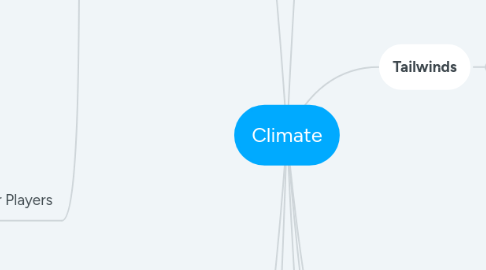
1. Overview
1.1. Fields
1.1.1. Renewable Energy
1.1.1.1. Wind Power: Onshore and offshore wind farms, turbine manufacturing.
1.1.1.2. Solar Power: Investments in photovoltaic (PV) technology, solar farms, residential and commercial installations.
1.1.1.3. Hydropower: Large-scale dams, small-scale hydro projects.
1.1.1.4. Emerging Technologies: Geothermal, wave, and tidal energy.
1.1.2. Energy Efficiency
1.1.2.1. Buildings: Retrofitting, green building materials, smart thermostats, energy-efficient appliances.
1.1.2.2. Industrial Processes: Advanced manufacturing technologies, waste heat recovery.
1.1.3. Sustainable Agriculture and Land Uses
1.1.3.1. Precision Farming: IoT and AI for resource-efficient farming.
1.1.3.2. Organic Farming: Chemical-free farming practices.
1.1.3.3. Reforestation and Afforestation: Carbon credits, sustainable forestry.
1.1.4. Carbon Capture and Storage (CCS)
1.1.4.1. Direct Air Capture: Technologies for capturing CO2 directly from the atmosphere.
1.1.4.2. Carbon Sequestration: Geological storage, biochar.
1.1.5. Electric Vehicles (EVs) and Transportation
1.1.5.1. EV Manufacturing: Battery technology, charging infrastructure.
1.1.5.2. Public Transportation: Electric buses, urban transit solutions.
1.1.6. Climate Finance and ESG Investing
1.1.6.1. Green Bonds: Financing for environmentally friendly projects.
1.1.6.2. ESG Funds: Investment funds prioritizing environmental, social, and governance criteria.
1.2. Major Players
2. Subcategories
2.1. Insurance
2.1.1. climate risks
2.1.1.1. physical risks ie. flooding
2.1.1.2. transition risks changes in tech
2.1.2. US disaster rate (14/9/23)
2.1.2.1. increasing
2.1.2.1.1. insurance claims increase
2.1.3. Adaptive SAA plan (Strategic Asset Allocation)
2.1.3.1. Identify risks
2.1.3.2. Adjust based on risk
2.1.3.3. Invest in climate friendly
2.1.3.4. Mitigation strategies
2.2. Carbon Capture
2.2.1. KEY to reaching climate goals
2.2.1.1. Shipping hurdles (20/9/23)
2.2.1.2. The CCS market is experiencing rapid growth (18/10/23)
2.2.1.2.1. expected annual growth rate of 6.2% from 2023 to 2030.
2.2.1.2.2. Climeworks fights for $1T future funding
2.2.1.2.3. How to invest in CCS
2.2.1.3. AspenTech to focus on lithium recycling and carbon capture in India (18/10/23)
2.3. Construction Sector
3. Regulations
3.1. US
3.1.1. $1.2 billion in US funding to fight climate change
3.1.1.1. Through direct air capture plants
3.1.1.2. Companies: Occidental and Climeworks
3.1.2. carbon pricing scheme
3.1.2.1. creating a new market for carbon offsets
3.2. EU
3.2.1. carbon market regulation
3.2.1.1. covering both compliance and voluntary markets.
3.3. Other
4. Headwinds
4.1. Regulation
4.1.1. Voluntary carbon markets are currently unregulated
4.1.2. Due to lack of regulation - can lead to greenwashing.
4.2. Credibility
4.2.1. Lack of verifiable carbon offsets available in the voluntary markets.
4.3. Effectiveness
4.3.1. Debated among professionals
4.4. Leakage
4.4.1. Off shore production
4.4.1.1. There is a risk of leakage, where companies shift production to places with less stringent emissions regulations.
4.5. Insurance
4.5.1. See subcategories
4.5.1.1. material risk to insurers, with the potential to cause significant losses.
4.6. Risks
5. Tailwinds
5.1. Awareness
5.1.1. recognition is growing
5.2. Carbon markets
5.2.1. becoming more mainstream
5.3. Governments
5.3.1. increasingly adopting carbon pricing policies.
5.4. Regulatory Risks
5.4.1. Policy Changes: Uncertainty due to changing government policies and international agreements.
5.5. Market Volatility
5.5.1. Commodity Prices: Fluctuations in prices of raw materials (e.g., lithium for batteries).
5.5.2. Economic Conditions: Impact of global economic health on investment flows.
5.6. Technological and Operational Risks
5.6.1. Performance Uncertainty: Reliability and efficiency of new technologies.
5.6.2. Supply Chain Issues: Disruptions in sourcing materials and components.
5.7. Environmental and Social Risks
5.7.1. Climate Impact: Physical risks from climate change affecting operations and assets.
5.7.2. Community Relations: Social acceptance and impact on local communities.
6. Investment
6.1. Carbon offset projects
6.1.1. Carbon Removal (20/9/23)
6.1.2. Low carbon cement (20/9/23)
6.2. Enablers of Climate Adaptation (26/9/23)
6.2.1. Buildings and infrastructure resilience
6.2.2. Grid resilience
6.2.3. Water security and scarcity:
6.3. Enhanced weathering (25/9/23)
6.3.1. Silicate Carbon
6.3.1.1. New form of carbon capture
6.3.1.2. investment from Gates foundation
6.4. Blue Economy Stocks (27/9/23)
6.4.1. Sophie Biro's Ocean Heroes
6.5. Climate change companies to watch (4/10/23)
6.5.1. NuScale
6.6. Carbon Capture
6.7. Batteries
6.7.1. Heat-battery industry (26/10/23)
6.7.2. Check out CCI's mind map
7. Trends
7.1. Extreme weather affecting farming, housing (11/09/23)
8. News
8.1. Carbon markets accelerate progress towards net zero
8.2. The United States has suffered 23 billion-dollar disasters so far in 2023 (14/9/23)
8.2.1. country’s struggle to adapt to the effects of climate change.
8.2.2. a record for this point in the year
8.3. Eastern pacific is cooling unexpectedly (26/9/23)
8.4. COP28 (28/11/23)
8.4.1. Expect disapointment and you'll never be disapointed
8.5. Trapped Water (7/12/23)
8.6. Carbon Measurement Technology (8/12/23)
8.6.1. EarthOptics and Trace Genomics Collaborate
